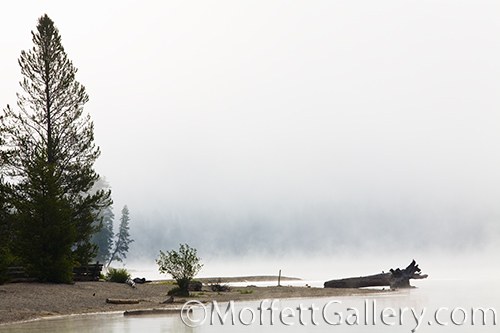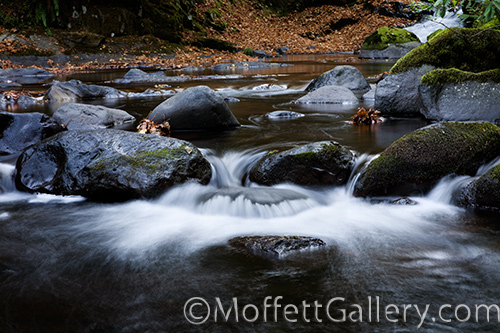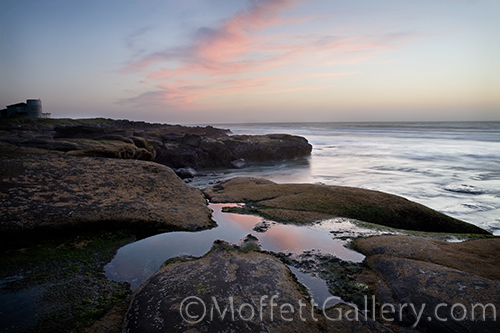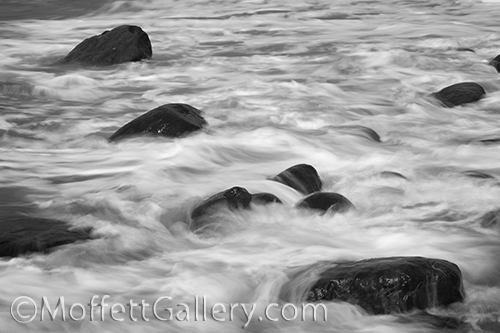by tmoffett | Oct 14, 2010 | Color, Composition, Landscape, Uncategorized

Foggy Morning, Redfish Lake
The Stanley are is one of my favorites! On one late summer morning I was treated to a heavy fog in the entire valley. As I drove toward Redfish Lake, the fog thinned out a bit so that the foreground was visible, but the trees across the lake were nearly gone. It was a beautiful sight. The fog was beginning to lift, so I didn’t have much time to photograph, but pausing for a moment first to take it all in and feel the surroundings (a necessity for me before photographing), I then proceeded to set up camera and tripod. I first made some images of the boats in the marina, then turned my attention toward the shoreline. I found this small peninsula with a large log, surrounded mostly by the morning fog, which provided the weight to balance with the trees at the left edge of the composition. The feeling of stillness, calm and peace prevailed with just enough detail to move the eye throughout the image to keep it interesting and hold attention. I love the trees just showing through the fog enough to create a bit of mystery. It was a great morning to be out enjoying God’s great creations.
by tmoffett | Oct 13, 2010 | Color, Landscape

Fall on Sweet Creek
Sweet Creek is a wonderful place to relax and enjoy nature. If you like the sound of rushing water, this is the place. It is loaded with one waterfall after another. It is definitely one of the prettiest places I have ever visited. Some days the words just don’t flow, and today is one of those days, so just enjoy the image!
by tmoffett | Oct 12, 2010 | Color, Landscape, Photo tips

Sunset Reflection, Yachats, Oregon
Light. Photography is all about light. Not just intensity, but more importantly quality. Photography means painting with light. As photographers, not understanding light is like a painter who doesn’t understand paint! Unfortunately there are too many photographers without a basic understanding of their craft.
My absolute favorite time to photograph the landscape is the 30 minutes after sunset. Why? because of the quality of light that is prevalent at that time. The light is soft, warm and moody. There is a balance between light on the foreground and the light in the evening sky that is wonderful! There is still direction to the light, yet it is still very controllable. The light intensity falls off fast, so there is not a lot of working time, so you must be ready and not expect to get a lot of exposures in, but the ones that you do get are great ones. My goal when I go out to shoot is one image. I may set up my equipment and photograph the same scene multiple times until the light is completely gone. This way, I can see the progress of the light from sunset through the glow of afterlight. This image went from great to gone in less than five minutes. If I had not been ready, I would have missed it.
Some of my other favorite lighting conditions are overcast, especially for landscape photography, reflected light for both landscapes and portraits and open shade, particularly for portraits. Learning the characteristics of light is critical to your success as a photographer.
by tmoffett | Oct 11, 2010 | Black and White, Composition, Landscape, Photographic Philosophy

Rocky Shoreline, 408 Trail, Yachats, Oregon
Shorelines is a portfolio of photographs that I have been working on for about a year now. It is all about water and land interaction along shorelines. Both ocean and lake shorelines are included in the series. I spend a lot of time in the outdoors, not only photographing, but fishing and just enjoying nature. I have been intrigued with water and land interactions for a long time. I have noticed both erosion and new life along the lakes I have camped at. Along the ocean I see the changes that happen with rising and ebbing tides. The calm waters in a tide pool or the rough waters of a stormy sea. It seems that the waters of the deep have little change, but at the shoreline the change is constant.
I have visited the same locations multiple times and never found the same thing twice. Ona Beach along the Oregon Coast, for one, in June had some incredible rock formations covered in moss along the shore, but in October those rocks are completely covered with sand. This occurs due to the shifting sands throughout the year. The light on a clear summer day will create a totally different look and feel than I will find on a stormy fall evening.
When photographing along a shoreline, I like to keep a sense of stability by maintaining some element in crisp focus, while letting other area blur with the motion of the water. In this image, the rocks protruding from the water provide that stability to the image, while the fast moving waters create a sense of movement and flow. The busyness of a stormy sea in contrast to the stability of solid rock. I can read the story of my life in the photographs that I create, but instead of telling my story, I want you to see yours.
by tmoffett | Oct 10, 2010 | Color, Photo tips, Photographic Philosophy, Ramblings

Starfish
While on the Oregon coast, low tide was an hour past sunset, so photographing at that time meant improvising lighting. I really dislike using flash as it is harsh and flat. My students all know how much I dislike it, as I don’t allow them to use it on camera. If I was going to photograph the tidepools, I needed an alternative source of light. I opted for a Mini Maglight which is a small flashlight that I carry with me in my truck all the time. This light would produce a warm light (extremely warm if you don’t correctly white balance!) in contrast to the very blue light from the nighttime sky.
After determining composition and setting up the camera, I carefully calculated exposure, and then used the trial and error method to fine tune it. I determined that about 90 seconds would be needed to illuminate the starfish. I set up, opened the shutter and began painting. At about 75 seconds a wave came from nowhere and forced me to retreat! This happens all to frequently on the ocean. You must be ready! When the wave came in, I had just finished painting the starfish and was working on the background area. Upon inspecting the image and the histogram on the cameras LCD monitor, I decided to leave it alone. I liked the dark surrounding and the cooler tones around the fish. It added a little bit more depth to the image. Success!
Students often tell me that it is too dark to photograph. Not true! You just have to look at alternate methods of lighting your images. Often, these alternative methods will produce much more interesting results than shooting when it is light outside. We must, as artists, be creative not only with our vision, but also with our technique. Learning technique so well that it becomes a part of us is so important. With technique under control, we are then able to concentrate on our vision, how we see and present our vision to others. That is when we truly become artists!







Recent Comments